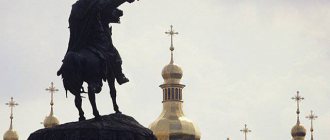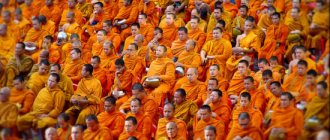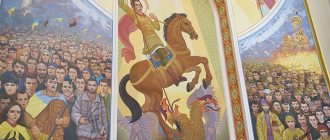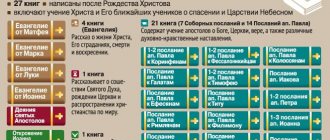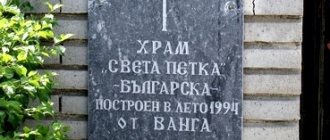What is tomos in religion in Ukraine?
First, to understand what is happening, you need to familiarize yourself with the terminology.
So, a tomos in religion is a special decree of a religious nature . It is published by the primate of the Orthodox church structure and contains a solution to an important issue regarding its structure. Most often it is used to ensure that the church receives autocephaly or the right to autonomous governance. The document also uses a solemn signature.
- The Tomos is provided by the Holy Synod of the Ecumenical Patriarchate, which makes a decision on the current issue.
- The issue of issuing a tomos is decided by voting among the members of the Synod, but the main word remains with Bartholomew, the Ecumenical Patriarch.
- After this, the document is signed by everyone who is a member of the Synod, including those who were against the decision or abstained from voting.
When all the signatures are ready, the tomos can be considered valid and unchangeable. The document usually does not have retroactive force, but in quite rare cases the decision can be changed by a new decree.
The content of the tomos consists of three parts:
- Historical section, which describes the religious organization of the country that requested autocephaly and its condition, as well as its relationship with Constantinople;
- Canonical justification. Here we talk about what canons this decision is justified by;
- The charter of the church, a list of its rights, as well as instructions to follow traditions and canons.
This video tells how the Ukrainian church gained independence after signing the tomos:
Ukrainian Tomos is a trap for world Orthodoxy
In physics there is the concept of “bifurcation point,” which denotes a critical state of a system when it becomes unstable and, due to the influence of external, even minor events, can move to a lower or, conversely, to a higher level of self-organization.
Events in Ukraine, in a certain sense, are such a “bifurcation point” for the entire world Orthodoxy. The decisions taken now and the actions taken will largely determine the future life of the Orthodox Church, perhaps for many centuries. In the current situation, it would be wrong to step aside, citing the fact that the Head of the Church is Christ and let Him manage everything Himself. Undoubtedly, He and only He heads the Orthodox Church, but the Church is a divine-human organism, and the Savior governs it in collaboration with people, taking into account our right and wrong desires and actions. Therefore, a falsely humble withdrawal from emerging church problems can lead to the worst possible result.
All Local Churches of the Orthodox world have entered a difficult period of decision-making regarding the Ukrainian religious organization created by the Patriarchate of Constantinople (hereinafter referred to as the Patriarchate) called the “Holy Church of Ukraine” (hereinafter referred to as the SCU). To make a responsible decision, it is necessary not only to know the real situation in Ukraine, where the absolute majority of Orthodox people are against the autocephaly imposed by Constantinople (2/3 versus 1/3), but also to carefully study the document - the tomos on the granting of autocephaly to the HCU, which is not addressed only to Ukrainians. schismatics and self-saints[1]. It contains statements that place the entire world Orthodoxy in a new, hitherto unprecedented position. Are representatives of Local Churches fully aware of the fact that, recognizing the HCU on the basis of this tomos, they also accept its content? Having crossed the line of “recognition,” Local Churches will fall into a trap from which they will no longer be able to get out. What is the danger? What does everyone who recognizes this tomos[2] implicitly agree to?
1. Recognition of the Patriarch of Constantinople as the head of the entire Orthodox Church and all Local Churches in particular.
In the tomos, our Lord Jesus Christ is never called the Head of the Church, but is referred to only as its Founder: “under the protection of the Founder of the One Holy Catholic and Apostolic Church, the God-man, our Lord and Savior Jesus Christ.”
In the tomos, Christ is never called the Head of the Church, but is called only its Founder
“His Beatitude Metropolitan of Kiev” is not named the head of the HCU either; he is referred to only as “first” and “primate.”
The concept of the head of the Church on a universal scale in the text of the tomos is clearly assigned only to the Patriarch of Constantinople, and representatives of the newly created Ukrainian structure must clearly realize that they do not have their own independent head: “The Autocephalous Church of Ukraine recognizes the head (κεφαλὴν) of the Holy Apostolic and Patriarchal Ecumenical Throne, as and other patriarchs and primates." In this one phrase, the autocephaly of the HCU is completely crossed out, for autocephaly is the independent, independent headship of the Local Church by a primate elected and approved at its own Church Council, which is reflected in the term “autocephaly” (from the Greek αὐτός “himself” + κεφαλή “head” ). In the Orthodox Church it is unthinkable for the head of an autocephalous Church to be a representative of another Local Church.
However, this phrase destroys the autocephaly of all other Local Churches, for it is stated that “other patriarchs and primates” recognize the Patriarch of Constantinople as their head. That is, the effect of this principle, according to the tomos, extends to all Local Churches and to all primates, and - what is most important - they supposedly recognize this. When and where did the Communist Party receive consent from the Local Churches to consider the Patriarch of Constantinople as its head?
It is stated that “other patriarchs and primates” consider the Patriarch of Constantinople to be their head!
It is difficult to get rid of the disturbing feeling that the text of this tomos has not yet been properly read by representatives of other Churches, because if they realized its content, the reaction would be clearly negative. For this phrase not only devalues the “autocephaly” of the HCU, but, in fact, rejects the full autocephaly of all Local Churches and declares the heresy of Constantinople papism, with which supposedly everyone agrees.
2. Recognition of the right of the highest peremptory court over all clergy of all Local Churches for the Patriarch of Constantinople.
The tomos states this directly: “The right of all bishops and other clergy to appeal to the Ecumenical Patriarch, who has the canonical responsibility to make peremptory judicial decisions for bishops and other clergy of the Local Churches, .” It is important to note here that the highest judicial power of the Communist Party is declared not only in relation to the clergy of the HCU, but extends to all clergy of world Orthodoxy. Now they can be tried in Istanbul, and these decisions must be made “without appeal” by any Local Church.
The tomos makes references to the 9th and 17th rules of the IV Ecumenical Council, in which there is not a word about the right of the Patriarch of Constantinople to judge representatives of other Local Churches. The most authoritative Byzantine canonist Zonara, interpreting the 17th canon, unequivocally denies such a right to Constantinople: “ The Patriarch of Constantinople is not appointed judge over all metropolitans without exception, but only over those subordinate to him . For he cannot bring to his court the metropolitans of Syria, or Palestine and Phenicia, or Egypt against their will; but the metropolitans of Syria are subject to the court of the Patriarch of Antioch, and the Palestinian ones to the court of the Patriarch of Jerusalem, and the Egyptian metropolitans must be tried by the Patriarch of Alexandria, from whom they receive ordination and to whom they are subordinate.” And the Monk Nicodemus the Holy Mountain in the famous “Pidalion”, commenting on these rules, categorically insists that: “The Primate of Constantinople does not have the right to act in the dioceses and areas of other patriarchs, and this rule does not give him the right to accept appeals on any case in the Universal Church " Having given many arguments, the Monk Nicodemus concludes: “ At the present time... the Primate of Constantinople is the first, only and last judge over the metropolitans subordinate to him - but not over those who are subordinate to the rest of the patriarchs. For, as we said, the final and universal judge of all patriarchs is the Ecumenical Council and no one else .” From the above, it clearly follows that the Communist Party does not have canonical rights to overturn court decisions made by other Local Churches.
At the same time, the Patriarch of Constantinople himself became beyond the jurisdiction of anyone. Theoretically, he could have been judged by the Ecumenical Council, but he usurped the right to convene it and thereby made himself an independent decider of the destinies of the Church. The Statutes of all Local Churches clearly state that primates are subject to the court of their Church[3], and nowhere is there a provision for judicial appeals to the Communist Party as the final authority in church disputes. At the same time, it is surprisingly accurate that the CP’s claims to the highest judicial power are consonant with the papist doctrine of the Catholics: “Peter and his successors have the right to freely pronounce judgment on every Church, and no one should in any way disturb or shake their fortunes; for the highest department is not judged by anyone (summa sedes a nemine judicatur) ”[4]. Do those who recognize the autocephaly of the HCU on the basis of this tomos agree to such innovations? This question must be asked of all Local Churches on the eve of making final decisions.
3. Subordination of the entire Orthodox diaspora[5] throughout the world to the Patriarch of Constantinople and limitation of the activities of Local Churches within the boundaries of the original national states.
In the text of the tomos, this idea is written first for the HCU, whose church life should take place strictly “within the geographical borders of Ukraine.” She “cannot appoint bishops or establish parishes outside the state; those already existing are henceforth subject, according to order, to the Ecumenical Throne, which has canonical powers in the diaspora , because the jurisdiction of this Church is limited to the territory of the Ukrainian state." Here, as in previous examples, the norm, first prescribed for the HCU, is presented as universal and generally accepted for all Local Churches (“submit, in accordance with the order , to the Ecumenical Throne, which has canonical powers in the Diaspora ”). Without coordination with other Churches, the rights of the Communist Party to have a worldwide diaspora are asserted. Those Local Churches that recognize the HCU must be prepared to abandon their spiritual children, parishes and monasteries abroad in favor of the Communist Church. Are they aware of this fact?
Local Churches, having recognized the HCU, will have to abandon their spiritual children abroad in favor of the Patriarchate of Constantinople
4. Recognition of the Communist Party as the highest authority in resolving dogmatic, canonical and other church issues.
Despite the lack of a convincing justification for their exclusive rights, the tomos contains a requirement for the HCU to submit to the Communist Party in resolving dogmatic and canonical issues: “To resolve major issues of an ecclesiastical, dogmatic and canonical nature, His Beatitude the Metropolitan of Kiev and All Ukraine, on behalf of the Holy Synod of his Church, should contact to our Holy Patriarchal and Ecumenical Throne, trying to understand what his authoritative opinion and position is (on this issue).” There is no direct statement here that other Local Churches do the same, because this would be a blatant lie, but there is no doubt that the Ukrainian precedent will be used against other Local Churches, especially those that recognize this tomos and the newly formed HCU.
Since the Communist Party has usurped the right to final church decisions, the question arises: where is the guarantee of the truth and infallibility of these decisions? If this guarantee does not exist, then there can be no right to such peremptory decisions. And if there is such a guarantee, then I would like to familiarize myself with it. Until now it has not been presented to the fullness of the church. Moreover, church history is replete with facts of doctrinal, canonical and moral betrayal of Orthodoxy by the Patriarchs of Constantinople. Suffice it to remember that on the throne of Constantinople during its existence there were significantly more officially convicted heretics than on all other Orthodox thrones combined. How can such rights be granted to the CP after this?
Archpriest Vadim Leonov, associate professor of Sretensky Theological Seminary
We have before us direct evidence of the usurpation of church power, which belongs exclusively to church councils. Are representatives of other Local Churches ready to abandon the principle of conciliarity in favor of Constantinople inerrancy in dogmatic and canonical matters? Without resolving these issues, agreeing to this tomos is essentially signing a death warrant for both your autocephaly and world Orthodoxy[6].
5. Recognition of the right of the Patriarch of Constantinople to intervene in the internal affairs of all Local Churches.
The tomos baselessly states that the KP, “according to centuries-old canonical tradition, is obliged (ὑποχρεωμένον) to worry about the Holy Orthodox Churches, which have a need for this.” Who obliged him to do this? Based on what council decisions? When did Local Churches express consent to such mandatory intervention? One of the reasons for the invasion of the Communist Party into the internal affairs of the autocephalous Churches is indicated in the tomos - this is the supposed healing of schisms: “ Out of duty of care of the Great Church of Christ for the Orthodox world, for the healing of the constantly threatening schisms and divisions in the Local Churches .” When did this responsibility arise for the Communist Party to deal with schisms in other Local Churches? Did other Local Churches agree with similar claims? The Istanbul hierarchs do not and cannot give an answer to these questions, since there is no convincing argumentation for such claims.
However, there is no doubt that all autocephalous Churches that recognize the HCU will thereby find themselves defenseless before the concerned Istanbul guardians. The Istanbul hierarchs have repeatedly demonstrated their ability to broadly interpret their own statements, and they will definitely extend this precedent of the subordination of some Local Churches to everyone and forever. For example, in the tomos issued by the Communist Party for the Polish Orthodox Church in 1924, a reservation was made that the alleged transfer of “the metropolis of Kiev and the Orthodox Churches of Lithuania and Poland dependent on it, as well as their inclusion in the Holy Church of Moscow, were carried out completely from the very beginning not in accordance with legal canonical regulations." Time passed, and the Istanbul hierarchs, taking advantage of the political instability in Ukraine, began to lay claim to the Kyiv Metropolis, citing, among other things, this clause in the Polish tomos[7]. So the conditions that are set out in the Ukrainian tomos will not be presented to other Local Churches immediately, but as soon as instability and suitable opportunities for invasion arise in their lives.
6. False argumentation.
The tomos states that in Ukraine “state and church leaders... have been ardently asking for church self-government for almost thirty years.” Regarding the “church leaders”, this is an outright lie, because during the mentioned thirty years they never turned to the Communist Party with a request for “church self-government”, because they have long had complete church independence (since 1990). Moreover, the Communist Party ignored over 400 thousand signatures[8] of the faithful children of the canonical Ukrainian Orthodox Church against the autocephaly imposed on them. The tomos completely ignores the canonical “church leaders”, followed by the overwhelming majority of the Orthodox flock in Ukraine, but the anathematized and excommunicated self-saints and schismatics are named as such, primarily M. Denisenko, whom the Communist Party considered to have fallen away from the Church until recently. From the opposite side, decisions of several Ukrainian politicians, who have an incredibly low trust rating among their people, were brought to Istanbul. Therefore, the further words in the tomos: “...and side by side with the people and in tune with their long-standing requests, at one time addressed to the Most Holy Apostolic See of Constantinople” are a continuation of a shameless lie.
7. Extreme self-exaltation of the KP.
The tomos builds the subordination of autocephalies: at the top, Constantinople is the universal “mother”, and at the bottom are her “daughters”
The text of the tomos is filled with self-exaltation of the Communist Party over all autocephalous Churches and the assimilation of absolute names for itself. For example, “The Great Church of Christ” - this name is appropriate for the entire Orthodox Church, but not for any Patriarchate, however, the Communist Party “humbly” appropriated this name to itself and is waiting for an appropriate attitude. The HCU for the Communist Party is a “daughter” that all other Local Churches must accept as a “sister”. It follows that the Communist Party considers itself a “mother” for all Local Churches. In other words, a subordination of autocephalies is being built, where at the top there is the KP - the universal “mother”, and at the bottom - her “daughters”. It is interesting to note that in the tomos of the Polish Church (1924) the KP professes her as a “spiritual sister”. As we can see, over the past years, the status self-esteem of the CP has increased significantly.
The Communist Party “modestly” calls itself the “Center of Orthodoxy,” although it is very strange to apply this concept to a throne that has fallen into heresies more often than all other primates of the Churches combined.
***
To summarize the brief analysis of the text of the Ukrainian tomos, we can say that the hierarchs of the Local Churches, who are going to recognize the quasi-autocephaly of the HCU on the basis of this tomos, thereby recognize:
- the Patriarch of Constantinople as the head of his Local Church;
- the right of the Patriarch of Constantinople to conduct a peremptory trial of all clergy of his Local Church;
- readiness to resubordinate its Orthodox diaspora to the Patriarch of Constantinople and limit the activities of its Local Church to the framework of its national state;
- the need to coordinate important church issues with the Communist Party as the highest authority in the field of dogmatic and canonical truths;
- the right for the Patriarch of Constantinople to intervene in the internal affairs of his Local Church under the guise of healing schisms and on other grounds;
- KP “Center of Orthodoxy” and “Great Church of Christ”, despite all its lawless acts and false statements contained in the Ukrainian tomos.
In addition, by entering into liturgical communion with schismatics and self-saints from the HCU, the clergy of the Local Churches will grossly violate the 10th rule of the holy apostles: “If anyone prays with someone who has been excommunicated from church communion, even if it was in the house, let him be excommunicated” - and Rule 33 of the Council of Laodicea: “It is not proper to pray with a heretic or renegade (schismatic).”
The provisions of the tomos are aimed at one goal - to implant the heresy of papism in Orthodoxy
To briefly express the essence of the above, then all the claims of the Communist Party indicated in the tomos are aimed at one goal - to implant the heresy of papism in Orthodoxy, according to which it is no longer necessary to recognize Christ as the head of the Universal Church, but the Patriarch of Constantinople and to submit to his will always and in everything. Thus, the tomos of the HCU is not only catering to the interests of Ukrainian politicians, the legalization of schismatics and self-saints, but - what is much more important - it is a declaration of the heresy of Constantinople papism, secured by the signatures of Patriarch Bartholomew and all the highest hierarchs of the Communist Party. Local Churches that recognize the tomos will not only demonstrate their readiness to submit to the new pope, but will also take responsibility for the establishment and spread of the heresy of Constantinople papism in Orthodoxy . I am convinced that if this idea is properly understood by the senior leadership of the Local Churches, then the desire to reject the Ukrainian church adventure organized by the Communist Party will be universal and salutary not only for world Orthodoxy, but also for the Constantinople hierarchs, who, apparently, have already decided that “the vineyard of God” became their property (see: Matt. 21: 33–41).
What is a local church in Ukraine?
There has long been talk in the media that Ukraine wants to establish an autocephalous local church on its territory. This means that in this state the church will be independent from religious organizations in other countries, and will also have its own structure.
Thus, this term is understood as an independent religious structure, independent of others, which is located on the territory of a certain state. Most often, such an organization is national.
This type of church system includes Russian, Polish, Romanian, Greek and many others around the world.
A special feature is that in Orthodoxy there is no single center, like the Vatican in Catholicism. All religious structures are independent, but interact with each other, and the status of the Ecumenical Patriarch of Constantinople is an exclusively formal title.
What Thomas looks like about autocephaly in Orthodoxy
Thomas on autocephaly is an extremely important document, which differs from other decrees in the solemn ritual of signature, according to specially developed regulations. The document is a roll reminiscent of ancient letters, decorated in a ceremonial manner.
Orthodox Thomas consists of two points:
- Historical background . The first part of Thomas talks about the situation of the Church, which claims to receive the status of autocephaly, and also describes the connection with the Patriarchate of Constantinople.
- Canonical and dogmatic justification . In the second part of Thomas in Orthodoxy it is indicated on the basis of which canonical laws the Church is awarded a document of independence. And also, instructions for church ministers are listed, for example, the desire to return Faith in God and be guided by canonical rights and laws.
Church organizations
The establishment of a single autocephalous church on the territory of this country is of particular importance for it, since a difficult situation has developed here.
The fact is that some time ago, in the early 1990s, a split occurred, as a result of which three independent church organizations appeared:
- Ukrainian Orthodox Church of the Kiev Patriarchate , considered a self-imposed autocephaly;
- Ukrainian Orthodox Church of the Moscow Patriarchate , subordinate to the Russian Orthodox Church;
- Ukrainian Autocephalous Orthodox Church , which has not been recognized as official.
The existence of three independent Christian structures in this country does not contribute to a favorable atmosphere in society.
In addition, an independent religious entity, the borders of which coincide with the borders of the state itself, is one of the guarantors of its independence. Therefore, the need to establish a single autocephalous church organization that will be officially recognized by other states is obvious.
Svyatogorsk Tomos
The Svyatogorsk Tomos is a message of 1340 from St. Gregory Palamas signed by authoritative monks of Holy Mount Athos. It was directed against the heretic Barlaam of Calabria, who later converted to Catholicism and became a bishop. Without naming Varlaam, the Svyatogorsk tomos condemned the heretic’s teachings “about the uncreatedness of only the essence, but not the energies of God; about imitation as the only path to deification; about the messalianism of those who call divine grace uncreated, unborn and hypostatic, about the Tabor light as a transitory phenomenon and sign; denial of the participation of the body along with the soul in the grace given by God to the mysteriously and ineffably purified mind.” The teachings of Varlaam were condemned by two Councils of St. Sophia in 1341 and the Council of Blachernae in 1351.
How did Ukraine try to achieve autocephaly?
For the first time, this state made an official statement about its desire to create an autocephalous church back in April 2021. Since then, having gone through a long and difficult path, during which it faced refusals and obstacles, Ukraine has finally been closer than ever to receiving the tomos.
- in September last year, envoys of the Church of Constantinople arrived in the country to visit cathedrals and temples in Ukraine and communicate with local clergy;
- The first meeting of the Synod, at which the issue of issuing a tomos to Ukraine was discussed, took place on November 9. During the meeting, the Synod listened to the reports of the envoys who spent about a month in this country, after which the decision to issue the tomos was approved;
- from November 27 to 29, a solemn meeting of the Holy and Sacred Synod of the Ecumenical Patriarchate was held, at which the text of the tomos of the Ukrainian Church, as well as its charter, was finally agreed upon;
- On December 15, an official statement was made about the establishment of a single Orthodox Church on the territory of Ukraine;
- just recently, on January 5, in the Church of St. George, the tomos was signed by Bartholomew, the Ecumenical Patriarch;
- the next day, Bartholomew handed over the staff and tomos to Metropolitan Epiphanius of Pereyaslavl and Belotserkovsky, thereby finally proclaiming autocephaly.
Tomos of Constantinople
Since 1850, the concept of “Tomos of Constantinople” has been understood as the official church document of the Patriarch of Constantinople, which is granted to the new independent Church upon receipt of autocephaly. This document, as a rule, clearly states the conditions under which the new autocephalous Church receives its independence from Constantinople.
It should be taken into account that the practice of creating independent (autocephalous) Churches existed before this, then other decision-making procedures were used.
And of course, the most ancient Churches, such as Jerusalem, Alexandria or Antioch, do not have any tomos - they trace their history back to the first Christian communities founded by the apostles.
In connection with the events surrounding the debate about Ukrainian autocephaly, references to several more documents periodically emerge that actually have no direct relation to current events:
What changes can Ukrainians expect now?
Such an event is a very important step in the history of the country, which will undoubtedly entail changes in some areas of the life of believing citizens.
- The most important change will be the elimination of the confusion and inconvenience caused by the existence of several churches. Often believers did not know which of them to turn to for the appropriate rite, since church organizations denied some of each other’s traditions. Now all rituals and canons will become uniform throughout the entire state, which will relieve believers from unnecessary worries;
- Ukrainian Orthodox clergy of the Moscow Patriarchate are given a choice. They must either come under the jurisdiction of the Orthodox Church of Ukraine, or be officially considered part of the Russian one;
- There will be no significant changes at the state level. The same applies to property that was in the hands of a religious structure.
Thus, a single autocephalous Ukrainian Orthodox Church has finally been established on the territory of this state, and this is definitely a big event for this country. Firstly, this was another step towards the independence of the state. Secondly, this will greatly simplify the life of religious citizens.


